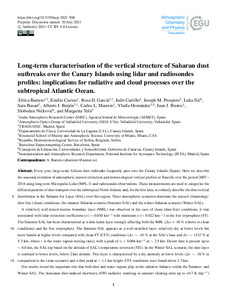Por favor, use este identificador para citar o enlazar este ítem:
http://hdl.handle.net/20.500.11765/13040
Long-term characterisation of the vertical structure of Saharan dust outbreaks over the Canary Islands using lidar and radiosondes profiles: implications for radiative and cloud processes over the subtropical Atlantic Ocean
Registro completo de metadatos
| Campo DC | Valor | Lengua/Idioma |
|---|---|---|
| dc.contributor.author | Barreto Velasco, África | es_ES |
| dc.contributor.author | Cuevas Agulló, Emilio | es_ES |
| dc.contributor.author | García Cabrera, Rosa Delia | es_ES |
| dc.contributor.author | Carrillo Pérez, Judith | es_ES |
| dc.contributor.author | Prospero, Joseph M. | es_ES |
| dc.contributor.author | Ilic, Luka | es_ES |
| dc.contributor.author | Basart, Sara | es_ES |
| dc.contributor.author | Berjón, Alberto | es_ES |
| dc.contributor.author | Marrero, Carlos | es_ES |
| dc.contributor.author | Hernández Pérez, Carmen Yballa | es_ES |
| dc.contributor.author | Bustos Seguela, Juan José de | es_ES |
| dc.contributor.author | Nickovic, Slodoban | es_ES |
| dc.contributor.author | Yela González, Margarita | es_ES |
| dc.date.accessioned | 2021-08-06T07:00:13Z | - |
| dc.date.available | 2021-08-06T07:00:13Z | - |
| dc.date.issued | 2021 | - |
| dc.identifier.citation | Atmospheric Chemistry and Physics Discussions. 2021 | es_ES |
| dc.identifier.issn | 1680-7367 | - |
| dc.identifier.issn | 1680-7375 | - |
| dc.identifier.uri | http://hdl.handle.net/20.500.11765/13040 | - |
| dc.description.abstract | Every year, large-scale African dust outbreaks frequently pass over the Canary Islands (Spain). Here we describe the seasonal evolution of atmospheric aerosol extinction and meteorological vertical profiles at Tenerife over the period 2007–2018 using long-term Micropulse Lidar (MPL-3) and radiosondes observations. These measurements are used to categorise the different patterns of dust transport over the subtropical North Atlantic and, for the first time, to robustly describe the dust vertical distribution in the Saharan Air Layer (SAL) over this region. Three atmospheric scenarios dominate the aerosol climatology: dust-free (clean) conditions, the summer-Saharan scenario (Summer-SAL) and the winter-Saharan scenario (Winter-SAL). A relatively well-mixed marine boundary layer (MBL) was observed in the case of clean (dust-free) conditions; it was associated with lidar extinction coefficients (α) ∼ 0.030 km−1 with minimum α (< 0.022 km−1) in the free troposphere (FT). The Summer-SAL has been characterised as a dust-laden layer strongly affecting both the MBL (∆α = 48 % relative to clean conditions) and the free troposphere. The Summer-SAL appears as a well-stratified layer, relatively dry at lower levels but more humid at higher levels compared with clean FT (CFT) conditions (∆r ∼ −44 % at the SAL’s base and ∆r ∼ +332 % at 5.3 km, where is the water vapour mixing ratio), with a peak of α > 0.066 km−1 at ∼ 2.5 km. Desert dust is present up to ∼ 6.0 km, the SAL top based on the altitude of SAL’s temperature inversion (STI). In the Winter-SAL scenario, the dust layer is confined to lower levels, below 2 km altitude. This layer is characterized by a dry anomaly at lower levels (∆r ∼ −38 % in comparison to the clean scenario) and a dust peak at ∼ 1.3 km height. CFT conditions were found above 2.3 km. Our results reveal the important role that both dust and water vapour play in the radiative balance within the Summer- and Winter-SAL. The dominant dust-induced shortwave (SW) radiative warming in summer (heating rates up to +0.7 K day−1) is found slightly below the dust maximum. However, the dominant contribution of water vapour was observed as a net SW warming observed within the SAL (from 2.1 km to 5.7 km) and as a strong cold anomaly near the SAL’s top (−0.6 K day−1). The conventional description of the Summer-SAL as a “dry layer” might lead to underestimating the importance of the atmospheric water vapour radiative effect. In the case of the Winter-SAL, we observed a dust-induced radiative effect dominated by SW heating (maximum heating of +0.7 K day−1 at 1.5 km, near the dust peak); both dust and atmospheric water vapour impact heating in the atmospheric column. This is the case of the SW heating within the SAL (maximum near the r peak), the dry anomaly at lower levels (∆r ∼ −38 % at 1 km) and the thermal cooling (∼ 0.3 K day−1) from the STI upwards. Finally, we hypothesise that the SAL can impact heterogeneous ice nucleation processes through the frequent occurrence of mid-level clouds observed near the SAL top at relatively warm temperatures. A dust event that affected Tenerife in August 2015 is simulated using the regional DREAM model to assess the role of dust and water vapour carried within SAL in the ice nucleation processes. The modelling results reproduce the arrival of the dust plume and its extension over the island and confirm the observed relationship between the Summer-SAL conditions and the formation of mid- and high-level clouds. | es_ES |
| dc.language.iso | eng | es_ES |
| dc.publisher | European Geosciences Union | es_ES |
| dc.rights | Licencia CC: Reconocimiento CC BY | es_ES |
| dc.subject | Lidar | es_ES |
| dc.subject | Radiosondes | es_ES |
| dc.subject | African dust | es_ES |
| dc.subject | Atmospheric aerosol | es_ES |
| dc.title | Long-term characterisation of the vertical structure of Saharan dust outbreaks over the Canary Islands using lidar and radiosondes profiles: implications for radiative and cloud processes over the subtropical Atlantic Ocean | es_ES |
| dc.type | info:eu-repo/semantics/preprint | es_ES |
| dc.relation.publisherversion | https://doi.org/10.5194/acp-2021-508 | es_ES |
| dc.rights.accessRights | info:eu-repo/semantics/openAccess | es_ES |
| Colecciones: | Artículos científicos 2019-2022 | |
Ficheros en este ítem:
| Fichero | Descripción | Tamaño | Formato | ||
|---|---|---|---|---|---|
| acp-2021-508.pdf | 5,67 MB | Adobe PDF |  Visualizar/Abrir |
Los ítems de Arcimis están protegidos por una Licencia Creative Commons, salvo que se indique lo contrario.





